Abstract
Due to the requirements of manufacturing miniaturized high-tech products, micromachining with micromachine tools has come to be regarded as an important technology. The main goal of this study is to build up the key technologies, including optimal structure and configuration design, synchronous driving control, analysis of optimal accuracy, in order to develop a low-cost and high-accuracy micromachine tool with a multi-degrees of freedom (DOF) platform with a co-plane synchronous driving mechanism. Due to the advantages of such a mechanism, the machine is able to possess a high feed resolution and high accuracy without the use of expensive drive components and high-end CNC controllers. Because of the no pile-up structure, the machine has less movement inertia effect, as well as the merits of light weight, high stiffness, and increased stability. Furthermore, the machine has more DOF, resulting in a better cutting performance than that of 3-DOF machine tools. To better understand the characteristics of major error sources of the machine in order to further enhance its accuracy, hybrid error analysis, kinematics analysis, and a volumetric error model were conducted. Finally, a prototype of the designed micromachine tool was built, and cutting experiments for accuracy calibration and verification were carried out using this machine. The results showed that the machine was able to effectively execute 4-DOF microcutting with positioning accuracy of 800 nm.
1. Introduction
The development trend of light, thin, short, and small consumer products has led to the demand for micromachining processes, which require highly accurate, versatile, and stable micromachine tools [1,2,3,4]. The development of advanced micromachining technology to produce high-quality micro products with excellent dimensional tolerances is required. The innovation of micromachine tools plays an important role in micromachining applications in modern industry. Due to the miniaturized nature of micromachining systems, micromachining is different from conventional machining technology in terms of processes, tool, material, machine and equipment, which is challenging in the development of micromachining technology [5]. To provide the high feed resolution and accuracy required micromachining processes, high-end driving units and CNC controllers have typically been used for the micromachines, but this also leads to a high cost for the machine. Considering the practical needs of industry, it would be better to achieve excellent machining performance while simultaneously maintaining the low cost of the micromachine tools when designing the machine.
To achieve high-precision feed movement, Park et al. [6] proposed the use of hydraulic bearings to enhance the accuracy of platform displacement. Takeuci et al. [7] also proposed a special mechanism design, so that the ultra-precision machine tool would experience lower contact friction during movement in order to achieve the goal of sub-micron feed accuracy. Wang et al. [8] used surface curvature as guidance for feedrate adjustment to improve the machining efficiency of a diamond turning machining. However, this method generated micro-fluctuations in the machining process, deteriorating the surface quality. Currently, the hydraulic slide method, driven with linear motors, is widely used to enhance the feed resolution. The advantages include high speed, low friction, no backlash, and high resolution. However, it also possesses disadvantages, such as high manufacturing cost, the effect of thermal deformation error, and difficult assembly.
At present, micro CNC machine tools still widely use the traditional serial-connected type structure and configuration, with a high-precision servo feed system consisting of linear guide ways and a high-level controller in order to obtain high feed resolution and high positioning accuracy. This usually results in the machine having a high manufacturing cost, which influences willingness to use them. Wang et al. [9] proposed a high-precision and low-cost micromachine tool with a double-toggle-type structure. The machine was able to provide ultra-precision feed resolution and positioning accuracy without using very high-end (expensive) driving components or an expensive CNC controller. To provide more flexible capability for micromachining implementation, Wang et al. [10] further proposed a design for a micromachine tool with a tilt-drive mechanism. The mechanism was able to provide not only ultra-fine feed resolution and excellent positioning accuracy for micromachining, but also an adjustable feed resolution and work range for different micromachining applications. Mechanism design, structure design/analysis, kinematics analysis and volumetric error model were studied, and hybrid error analysis and machinability tests were carried out in the study. Wojciechowski et al. [11] analyzed the micro end milling kinematics and geometric error of a micromachine tool, and established a model for predicting the cutting force during micro milling. Law et al. [12] developed a methodology for evaluating and improving the dynamic performance of the machine tool in the design stage that made it possible to identify the weak machine components to avoid chatter in productivity.
On the basis of the reasons mentioned above, the main objective of this study is to design a multi-DOF co-plane synchronous driving mechanism with the advantages of high accuracy, low movement inertia effect, and low cost for a 4-DOF micromachine tool. The main features of the proposed machine include: (1) tilt-drive mechanism. This has a high precision resolution with a fixed full stroke, and can reduce the size of the machine and the number of key parts, thus reducing the sources of potential error, as well. (2) Co-planar multi-DOF platform. The mechanism uses three sets of drive mechanisms with slide rails and bearings, which allows the platform to have an X-, Z-axis translation movement and a B-axis rotation. In addition, the machine weight can be greatly reduced, and the cumulative error between the servo shaft load and the platform can be also reduced.
Because micromachine tools have very strict requirements with respect to the static/dynamic rigidity of the structure itself, the optimal structure/configuration design were confirmed on the basis of static/dynamic stiffness and dynamic compliance analysis, kinematic analysis, hybrid error analysis in this study to ensure that the expected high accuracy of the machine was achieved. In addition, the influences of major error sources in key components on the accuracy of the proposed machine were determined in order to provide guidelines for the detailed machine design. Furthermore, kinematic equations were derived to analyze the following motion characteristics: (a) the relationship between platform feed resolution and tilt-drive angle, (b) the relationship between X and Z travel of the co-planar platform and tilt-drive angle, (c) the relationship between platform rotation resolution and rotation angle, (d) the displacement, velocity and acceleration of platform translation and rotation characteristics, (e) the relationship between spindle seat feed resolution and tilt-drive angle, (f) the relationship between Y-axis travel and tilt-drive angle, (g) the analysis of the displacement, velocity and acceleration characteristics of the spindle seat. When designing the tilt-drive angle and working travel range for the co-planar multi-DOF horizontal machine tool, the kinematic characteristics analysis can be used to confirm whether the design of the tilt-drive angle and related dimensions is able to meet the requirements of the machine design specifications. In this study, the D-H rule and the homogeneous coordinate transformation matrix in robotics theory were used to establish the kinematic model. Error sources were added to the kinematic model in order to establish the total error model of the machine. This error model can be used for sensitivity analysis to determine the sensitivity parameters of the major error sources, and thus to evaluate the influences of the error sources on the accuracy of the machine.
Due to the advantages of co-plane synchronous driving mechanisms, the micromachine does not need to use a high-end servo drive system and CNC controller to achieve high feed resolution and high accuracy. Because the major driving units lie on the same plane, the machine has a low center of gravity and low movement inertia, resulting in stable and accurate movement. Finally, a prototype of the designed machine was built, and machining experiments were carried out to verify the feasibility and effectiveness of the design. The experimental results showed that the design was feasible and effective.
The structure of this manuscript is as follows. In Section 2, the principle of the co-plane platform is elucidated. In addition, the kinematic characteristics of the machine tool structure are analyzed. In Section 3, the error model of the proposed machine is developed and used to explore the relationship of between the major error sources. In addition, sensitivity analysis was also conducted to analyze the influences of the major error sources on the accuracy of the proposed machine. In Section 4, verification experiments are carried out on the prototype machine and the results are discussed to confirm the accuracy and machinability of the proposed design and machine. Finally, the conclusions of this study are presented in Section 5.
2. Principle of the Co-Plane Platform
2.1. Principle
The horizontal-type co-plane multi-DOF micromachine tool was designed using a simple co-plane synchronously driven platform (Figure 1), which provides translational motion along the X- and Z-axes, rotation around the B-axis for the work table, and Y-axis translation (up and down movement) for the machine spindle. Compared with conventional serially stacked CNC machine tools, as a result of the co-plane platform not having a serially stacked structure, it does not require a large amount of driving power for the feed system on the lower level to move large structural masses, and it also will not encounter large amounts of movement inertia while it is moving. The platform uses three sets of tilt-drive mechanisms with rotating bearings arranged in a circular array. By controlling the drive shafts, the platform can have linear movement along the X-/Z-axes, as well as B-axis rotation. The driving unit of the platform consists of a ballscrew and a sliding rod, placed in a triangular geometry, thus achieving precise and high feed resolution due to the triangular proportional transformation. Furthermore, a double-column structure was designed for the machine spindle in order to provide Y-axis machining movement.
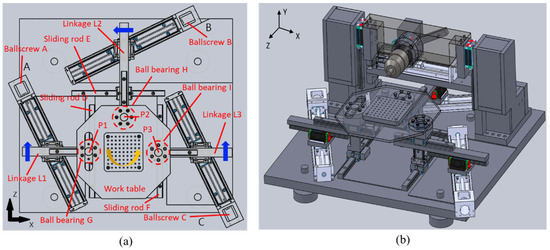
Figure 1.
Scheme of co-plane platform, (a) X-, Z- and B-axis motion, (b) the micromachine tool.
As shown in Figure 1, the co-plane platform consists of three sets of tilt-drive ballscrew servo system (A, B, and C in Figure 1) with the same tilt angle. The ballscrews with sliding rods (D, E, and F in Figure 1) are used to drive the platform to move in the X and Z directions. The ballscrew, sliding rod, and platform are connected by three movable linkages (L1, L2, L3). The sliding blocks on the sliding rods are respectively fixed at the three points (P1, P2, P3) with the work table. The three connection points are equidistant from the center of the work table, and are located on the center of the work table as the center of circle. When the feeds of sliding blocks are appropriately controlled, the table can conduct rotation about Y-axis. When this mechanism is applied to a micromachine tool, the machine can perform linear movements along the X- and Z-axes, as well as B-axis rotation (Figure 1).
As shown in Figure 1, when the A and C ballscrews are fixed and the B ballscrew is moving, the linkage L2 pushes the table to move along the X direction. The linkages L1 and L3 and the sliding rod E provide the function of movement guidance. When the B ballscrew is fixed, the A and C ballscrews move in the same direction at the same speed, while linkages L1 and L3 move the table along the Z-axis, as shown in Figure 1. At this time, sliding rods D and F and linkage L2 provide the function of movement guidance. When ballscrews A, B, and C are moving in the same direction at the same speed (CW or CCW), the moving paths of the three connecting points (P1, P2, P3) are the distances from each connecting point to the center of the platform (as shown in Figure 1), which drives the platform for rotational movement about the center of the platform. The bearing on the sliding rod provides rotational DOF to rotate the platform around the center of the platform.
This design provides 3 DOF movements (linear, moving along the X- and Z-axes, and rotation about the Y-axis) with a lighter inertia effect, and can also reduce the loading of the servo control system. Because the ballscrew drives operate using a tilt servo mechanism principle, the triangle geometric motion transformation will proportionally reduce the movement of the work table so that finer feed resolution can be achieved for the work table, and the errors caused by ballscrew backlash and pitch error can also be reduced. Because of the advantages mentioned above, the machine is able to achieve the high resolution and high precision required for micromachining without the use of high-end driving components or a CNC controller.
Figure 2a shows the ballscrew using the tilt-servo mechanism principle. Tilt angle is the angle between the ballscrew and the sliding rod. When the ballscrew nut moves, the platform moves along the guidance rail (perpendicular to the connecting rod direction). The movement of the platform will be reduced by a small proportion due to triangle geometric motion transformation. When the tilt angle is fixed, the travel distance, feed, and feed resolution of the platform can be consistently converted based on the triangle geometry principle.

Figure 2.
(a) Tilt-servo mechanism principle, (b) spindle seat with tilt-servo mechanism.
Figure 2b shows the spindle seat using the tilt-servo mechanism. Two sliding rails (K, M) are used for the Y-axis, and the sliding rail (N) is mounted on the spindle seat. The ballscrew and sliding rail N are connected by means of fixed link L4. When the ballscrew drives the ballscrew nut, the spindle seat will be moving along the Y-axis. The smaller tilt angle is able to produce higher feed resolution, but the spindle seat travel range becomes smaller, i.e., the travel range is smaller. Conversely, larger tilt angles result in lower feed resolution, but larger travel range of the spindle seat. The prototype of the micromachine tool with multi-DOF with horizontal co-plane has 4 DOF, including linear movement in the X, Y, and Z directions, as well as B-axis rotation.
2.2. Kinematic Analysis
Kinematic equations were derived, and thereafter used to analyze the following motion characteristics: (a) the relationship between feed resolution of platform and tilt-drive angle; (b) the relationship between the X and Z movement of the platform and the tilt-drive angle; and (c) the relationship between the rotation resolution of the platform and the range of the rotation angle.
- (a)
- Relationship between feed resolution of platform and tilt-drive angleWhile the platform carries out the axial feed, the resolution is decided by the tilt-drive angle. The feed resolution can be calculated as followswhere RP is the feed resolution of the platform, RB is the movement resolution of the ballscrew, and θ is the angle between the sliding rod and the ballscrew
- (b)
- Relationship between the X and Z movement of platform and the tilt-drive angleThe co-planar axial linear movement of the platform depends on the length of the ballscrew and the tilt angle. The relationship can be expressed as followswhere DP is the platform movement, DB is the ballscrew movement, and θ is the angle between the sliding rod and the ballscrew
- (c)
- The relationship between the rotation resolution of the platform and the range of the rotation angleTo understand the relationship between the rotation resolution of the platform and the rotation angle, it is necessary to first derive the relationship between the travel distance of the ballscrew nut and the rotational angle of the platform. When the platform is rotated, the travel distance of the tilt-drive servo sliding block (shown in Figure 3) can be calculated as followswhere l1 is the travel distance of the servo-drive sliding block when the platform rotates about the B-axis, f is the distance from the connection point to the center of the platform, θ’ is the angle before rotation, and θ” is the angle after rotation.
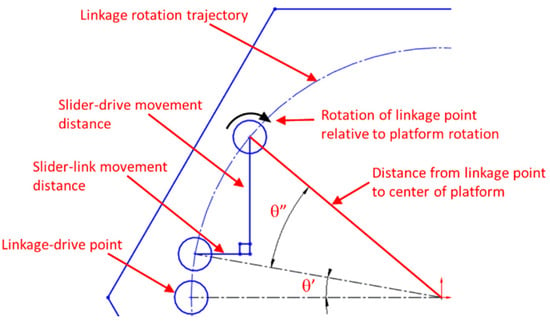 Figure 3. Travel distance of the servo-drive sliding block when the platform is rotating.
Figure 3. Travel distance of the servo-drive sliding block when the platform is rotating.
The difference between θ″and θ′ is the rotation degree of the platform. After substituting Equation (3) into Equation (4), the travel distance of the ballscrew nut can be calculated.
where DB1 is the travel distance of the ballscrew nut, and θ is the tilt-drive angle.
The shortest ballscrew travel gives the smallest rotation of the platform. Thus, the ballscrew feed resolution can be used to calculate the movement resolution of the platform by using Equation (1). By substituting Equation (1) into Equation (4), the relationship between rotation resolution and rotation range can be obtained using Equations (5) and (6).
where represents the rotation resolution of platform.
According to the equations explained above, a kinematic analysis was performed. Figure 4 shows the relationship between platform feed resolution and tilt-drive angle θ. It is noted that the larger the tilt-drive angle, the higher the feed resolution. By contrast, the smaller the tilt-drive angle, the lower the feed resolution. Figure 5 shows the relationship between the linear travel length of the platform and the tilt-drive angle. The results show that larger tilt-drive angles provide finer movement resolution, but the platform travel length will be smaller as a consequence. Conversely, a smaller tilt-drive angle provides coarser movement resolution and larger platform travel length. Figure 6 shows the relationship between the rotation resolution of the platform and the rotation angle. It is noted that rotation resolution will be decreased when the platform rotation angle is increased. It can be seen that the rotation resolution is quite consistent (0.003°~0.004°) for a working range of 0°~45°.
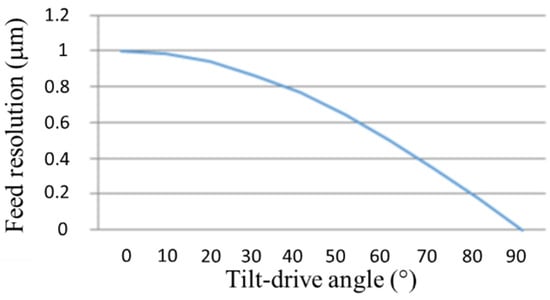
Figure 4.
Feed resolution vs. tilt-drive angle.

Figure 5.
Platform linear travel vs. tilt-drive angle.
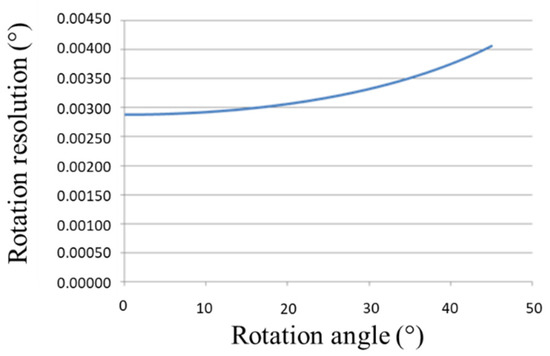
Figure 6.
Rotation resolution of platform vs. rotation angle.
3. Error Model and Analysis
3.1. Error Model
With the use of the co-planar multi-DOF machine kinematic model, the relative position of the working table with respect to the tool-end point can be determined (Figure 7). The model describes the relationship of motion between the tilt-servo mechanism and the platform. After obtaining the relative coordinate position of the working table with respect to the tool-end point, according to the parameters of the motion model, the error sources of the co-planar multi-DOF machine tool were defined. Subsequently, the defined error sources were combined with the kinematic model to obtain the total error model for the co-planar multi-DOF machine tool. The error sources in the coordinate transformation include translation errors (δx, δy, δz) in the three axes, rotation angle errors (rx, ry, rz) in the three axes, and the motion errors generated by the ballscrew nut movement (Δx, Δy, Δz). Firstly, the error parameters of each key component were defined. The translation error and rotation angle error are shown in Table 1. δx1, δy1, and δz1 in the table respectively represent the translational error in the X, Y, and Z directions when the coordinate frame O0 moves to the coordinate frame O1, and rx1, ry1, and rz1, respectively, represent the rotation angle errors of coordinate frame O0 to frame O1 about the X-, Y-, and Z-axes. The motion error parameters of the platform due to the movement errors of the ballscrew nut are shown in Table 2.
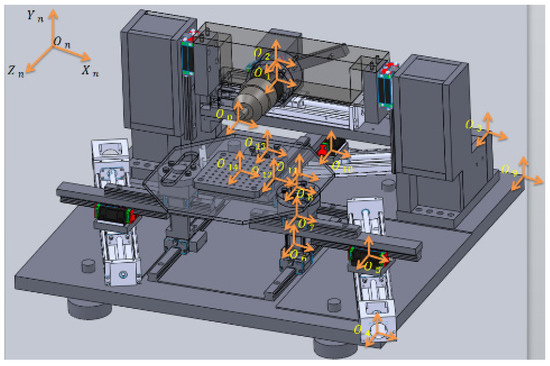
Figure 7.
Coordinate frames defined for the machine.

Table 1.
Parameters of translation and rotation error.

Table 2.
Motion error parameters of platform due to ballscrew nut movement.
After defining the error parameters, the error model was derived. The main structure of the co-planar multi-DOF horizontal machine tool includes a bottom co-planar multi-DOF platform for X-axis and Z-axis movement and a tilt-drive mechanism for Y-axis movement. The actual total coordinate transformation matrix of the horizontal co-planar multi-DOF machine tool is the result of multiplying the associated transformation matrices. Meanwhile, the translation errors (δx, δy, δz) and rotation angle errors (rx, ry, rz) need to be included in the transformation matrix. The rotation errors at the three axes are equivalent to rotating the three axis coordinates at the same time, as shown in Equation (7).
Based on the coordinate transformation matrix, and the translation error, rotation error and motion error sources in Table 1 and Table 2, the total error model was obtained, as described in Equation (8).
Under the assumption that the machining accuracy of the machine components, assembly accuracy, and the parallelism calibration of the machine are well controlled, it was assumed that the rotation angle error shown in Equation (8) was quite small, such that Sine terms and Cosine terms would be respectively close to 0 and 1. For example, if the parallelism of two 200-mm-long mating parts were to be assembled with a tolerance of ±0.01 mm in the design, the possible parallel angle error would be
Since the parallel angle error (Equation (9)) is quite small, sin(0.0029°) and cos(0.0029°) in Equation (8) are respectively close to 0 and 1. Hence, the error model can be further simplified as shown in Equation (10). Comparing the actual coordinates of the working table with the theoretical coordinates, the total position error of the tool can be determined by Equation (11). Finally, the volumetric error of the machine can be calculated by means of Equation (12).
where
3.2. Error Sensitivity Analysis
Understanding the influences of error sources on the volumetric errors of a machine can help to efficiently improve the machine design and the machine assembly work on the necessary parts with reasonable manufacturing cost. The equation for sensitivity analysis is presented in Equation (13).
where represents volumetric error; represents the sensitivity parameter; and represents error sources.
To analyze the sensitivity of the ballscrew motion and the tilt-drive angle on total machine errors, the differences between the ideal tool-end position and the actual tool-end position were substituted into Equation (11) under the condition that all other error sources were zero; consequently, the total position error of the machine can be expressed as follows.
where represent ballscrew motion errors along the X-, Y-, and Z-axes, respectively; represent the tilt-drive angle errors along X-, Y-, and Z-axes, respectively.
According to Equation (14), it is noted that the motion error of each ballscrew and the assembly error of the tilt-drive angle cause position errors at each axis. The position error at the X-axis can be derived from Equation (14), as
The sensitivity parameter of the ballscrew motion and the assembly error of the tilt-drive angle can be obtained by the differential of Equation (15), as follows.
The first sensitivity parameter, , is “”. This shows that this parameter will not change when the position of the platform changes, but it will change when the tilt-drive angle changes. Figure 8 shows the relationship between the parameter and the tilt-drive angle. The sensitivity parameter will decrease when the tilt-drive angle increases. That is, the larger the tilt-drive angle error, the lower the influence of this parameter. Another sensitivity parameter, , is “”, in which changes when the ballscrew position varies. It can be seen from Figure 9 that the value of the sensitivity parameter decreases when either of the tilt-drive angles increases.
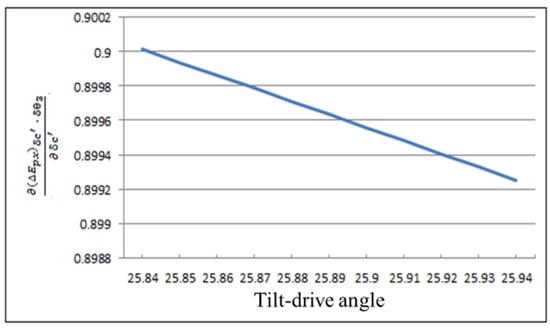
Figure 8.
Relationship between the ballscrew motion error δc′ and parameter sensitivity.
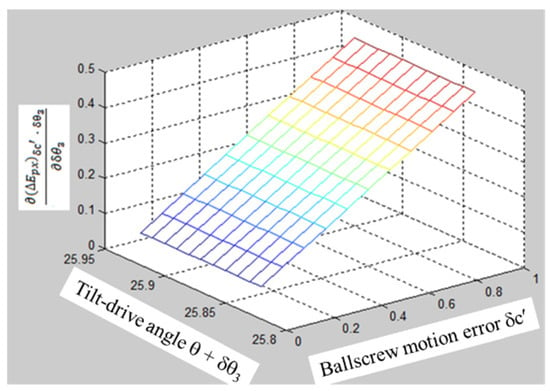
Figure 9.
Relationship between the tilt-drive angle assembly error δθ3 and parameter sensitivity.
By substituting the condition of the prototype machine—where the tilt-drive angle θ is 25.84°, the assembly error of the tilt-drive angle δθ3 is 0.05°, and the ballscrew motion error is 0.5μm—into Equation (17), it is found that machine accuracy can be controlled within a range of 1 μm. Additionally, it can be concluded that the ballscrew motion error source has a greater impact on the overall X-axis error. Similarly, the error source of the Z-axis ballscrew motion has a greater impact on the overall Z-axis error.
The position error of the Y-axis can be calculated using Equation (18). The sensitivity parameter of the ballscrew motion and the assembly error of the tilt-drive angle can be obtained by means of the differential of Equation (18), as follows.
The first sensitivity parameter of is “”. This parameter will not change when the platform position increases, but it will change when the tilt-drive angle changes (as shown in Figure 10). Furthermore, the sensitivity parameter will decrease as the tilt-drive angle increases. That is, the larger the error of the tilt-drive angle, the greater the effect of this parameter. Another sensitivity parameter of is “”, in which will change when the ballscrew position changes. This parameter will change when either the platform position or the tilt-drive angle increases (as shown in Figure 11). By substituting the conditions of the prototype platform—in which the tilt-drive angle θ is 25.84, the assembly error δθ4 is 0.05°, and the total ballscrew motion error is 0.5 μm—into Equation (20), it is noted that the machine error can be controlled within a range of 1 μm, which meets the design target of the prototype. Additionally, it can also be concluded that the ballscrew motion error source has a greater impact (almost linearly proportional) on the overall Y-axis error.
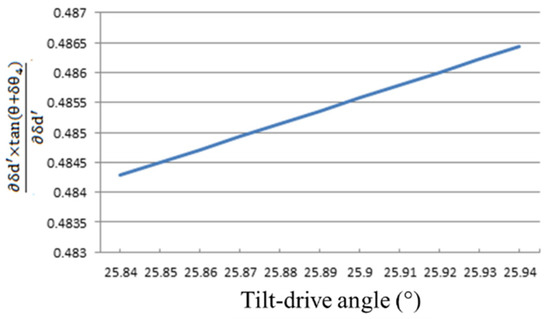
Figure 10.
Relationship between the ballscrew motion error δd′ and parameter sensitivity.

Figure 11.
Tilt-drive angle error δθ4 vs. the sensitivity parameter.
3.3. Ballscrew Motion Error and Feed Error Analysis
Because the tilt-drive mechanism adopts a triangular geometrical driving principle, the ballscrew motion and machining error will be reduced following the proportional relationship of triangle geometry. In this study, the influence of translation error (such as pitch error, etc.) on the platform movement was analyzed, and the rotation error of the ballscrew can be merged into the tilt-drive angle error. Taking ballscrew B as an example for the purposes of explanation, if ballscrew B has translational errors, since it drives the platform to move along the X-axis direction, the translational errors will influence the X-axis motion of the platform (as shown in Figure 12). When the tilt angle (the angle between ballscrew B and the sliding rail) is 25.84° and the motion error (the translational error) of the ballscrew is 0.5 μm, the feed motion error of platform will be 0.45 μm, which is only about 90% of the motion error of ballscrew B.
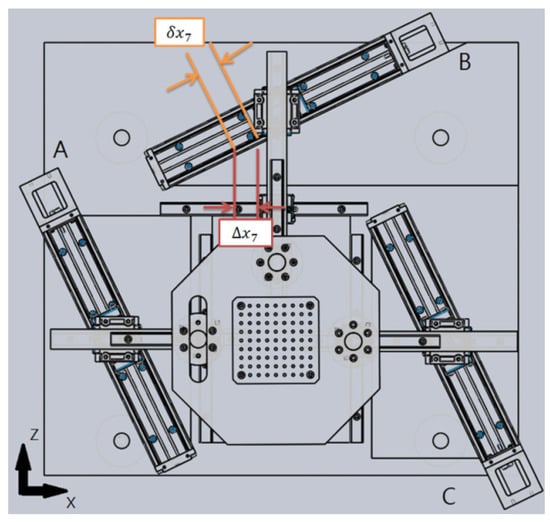
Figure 12.
Ballscrew B motion along the X-axis with translation error.
Similarly, the ballscrew motion error and platform feed error is illustrated in Figure 13. When the mechanism is designed with a tilt-drive angle of 25.84° and the ballscrew motion error of 0.5 μm (δx3), this results in a feed error of 0.242 μm (Δy3) for the platform, which is a reduction to 48% of the ballscrew motion error. If a machine is directly driven with the ballscrew with a motion error of 0.5 μm, it will have a feed error of at least 0.5 μm. That is, the designed mechanism has only about 50% of the error that the direct-driven mechanism has.
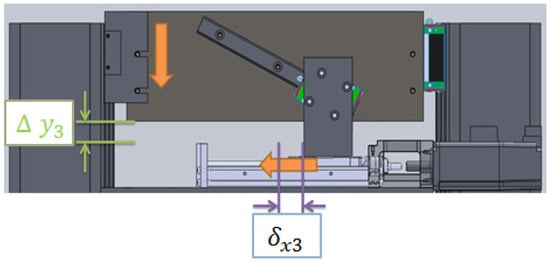
Figure 13.
Ballscrew D motion along Y-axis with translation error.
3.4. Tilt-Drive Angular Position Error and Feed Error Analysis
Since the tilt-drive angle of the mechanism affects the axis resolution, if assembly errors (between the ballscrew and the sliding rod) and errors in the ballscrew–sliding rod motion exist, it will cause motion errors for the platform movement. The influence of tilt-drive angle error on platform error was analyzed as a basic reference for design and assembly. The X-axis tilt-drive angle error was taken as an example to explain. The rotation error of the sliding rod is shown in Figure 14. When the ballscrew assembly generates rotation errors, it will result in resolution error for the platform motion. Different errors at different tilt-drive angles have different effects on the feed resolution of the platform. The prototype machine was designed with a tilt-drive angle of 25.84°, and this was also used for analysis. When the ballscrew assembly produces rotation errors, the movement ratio of the ballscrew and the platform changes, which also results in a change in the feed resolution of the platform (as illustrated in Figure 15). It can be seen from Figure 15, when the ballscrew moves for a distance B and there is a tilt-drive angle error of ry, an error of occurs in the feed direction (i.e., the X-axis direction). When the ballscrew moves to the next position (B+ΔB), an additional feed error is introduced. It is clear that when a tilt-drive angle error is present, the feed error of the platform is different at different travel locations of the ballscrew, and the error has a proportional relationship with the travel distance of the ballscrew, following the triangle principle. By substituting the condition that the tilt-drive angle is 25.84° into Equation (2), the feed resolution of the platform obtained is 900 nm. If the tilt-drive angle has an error ±0.5°, the feed resolution will, respectively, become 896.2 nm and 903.7 nm for tilt-drive angles of 26.34° and 25.34°. Compared to the platform feed resolution of 900 nm, the resulting error in platform feed resolution (3.8 nm) is less than 1/200 of the original platform feed resolution. This is because the error effect is reduced as a result of the triangular geometry.
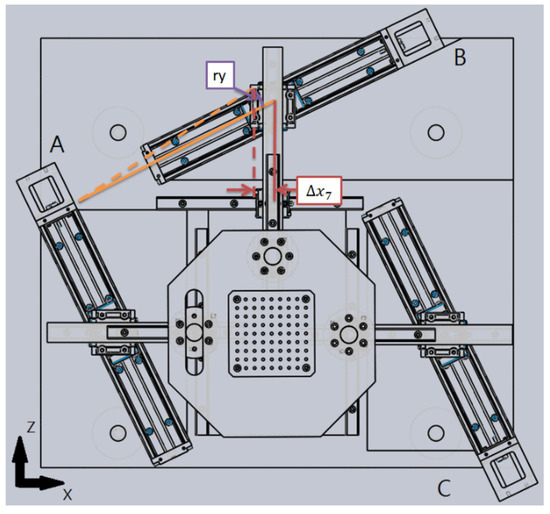
Figure 14.
Structure of the ballscrew B rotation error.
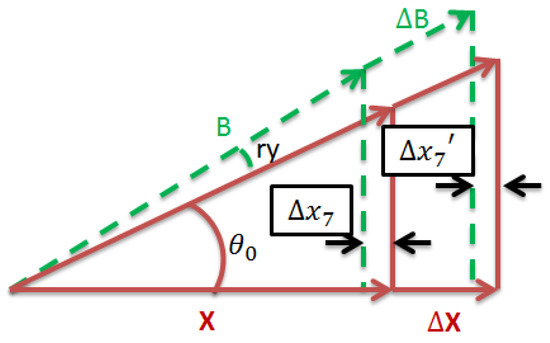
Figure 15.
Ballscrew B rotation error.
4. Accuracy and Machinability Test
The prototype machine was designed to have an X-, Y-, and Z-axis travel range of 60 × 40 × 40 mm, and the machine footprint is less than 60 × 60 cm, as shown in Figure 16. A high-speed spindle with a maximum speed of 150,000 rpm was used. Three sets of tilt-servo mechanisms were used, and were installed on the base of the machine table. Since the machine is of the horizontal type, the X- and Z-axis driving mechanisms were responsible for translational motion, and the B-axis mechanism was designed for the rotation motion about the Y-axis. The fourth tilt-servo mechanism was installed on the machine column to translationally drive the spindle in the Y-axis direction. Due to the requirements of high rigidity, a double-column-type mechanism was designed for Y-axis driving unit. The machine table was supported by three supporting points. Ball bearings were installed on the supporting points to provide low-friction rotation freedom for the B-axis. A sliding connecting rod was installed under the bearing, so that the platform can move along the X- and Z-axis slide rails. The driving unit used for each translational axis was composed of a servo motor and a linear guideway module. The ASDA-A2 series servo motor produced by Delta Electronics Inc. with a high-precision encoder was used. The linear guideway module was model KK50 with a 2 mm ballscrew pitch and a 300 mm stroke produced by made by Hiwin Corp.
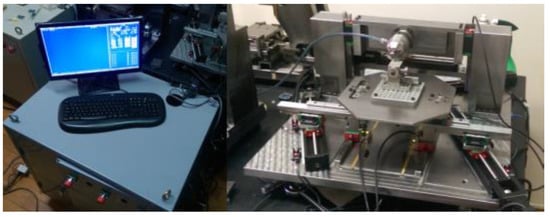
Figure 16.
Prototype of horizontal micromachine tool with co-planar multi-DOF.
A HP5529 laser instrument was used to check the position accuracy and repeatability of the machine. The measurement of the laser instrument was applied for a long travel range, and the microcapacitance was used to check the accuracy of small movements. The measurements were taken at three locations for each axis. At each location, several small movements with 1-mm intervals were made. According to the calibration results, the positioning accuracy of the machine was less than 0.8 μm. In addition, a vision measurement system was implemented to check the rotation accuracy. It showed that the machine was able to achieve a rotation accuracy of 0.008°.
To conform the four-axis machinability of the machine, two micromachining experiments were conducted. In the experiments, a microcutter with a diameter of 0.2 mm, a spindle speed of 150,000 rpm and a feedrate of 300 mm/min was used to cut a copper workpiece. Figure 17 shows the machined micro pattern, micro hole array, and micro characters. To verify the rotation degree of freedom of the B-axis, three micro holes were machined with tilting angles of 0°, 5°, and 10°. Figure 18 shows the cutting results. The test results show that the machine was able to provide the expected cutting performance with the expected 4-DOF movement, high feed resolution, and high accuracy.
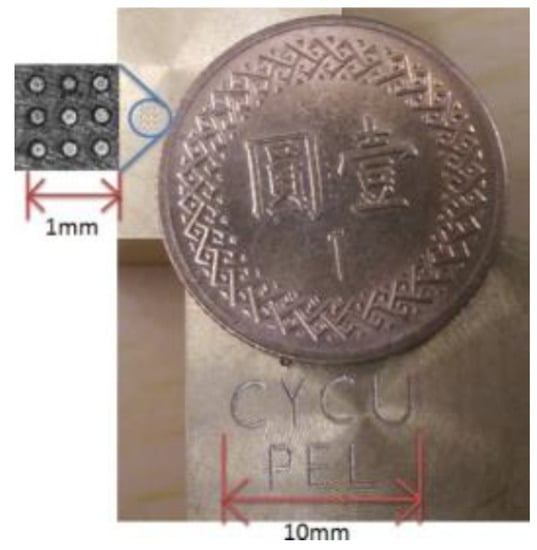
Figure 17.
Micro pattern, nine-hole array, and characters.
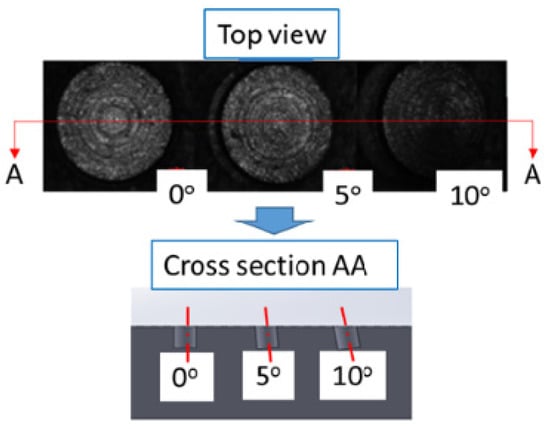
Figure 18.
Micro hole with different tilting angles.
5. Conclusions
A new structure design with a synchronous driving mechanism for a co-plane multi-DOF platform was proposed and verified in this study. Kinematic characteristics analysis and error analysis were conducted to complete the design of the machine. Subsequently, an integrating and tilting drive mechanism, a co-plane horizontal micromachine tool with the advantages of low center of gravity, low inertia effect, high accuracy, and low cost, was developed. A prototype of the proposed machine was built and used to conduct micromachining experiments to verify the feasibility and performance of the design. The experimental results showed that the machine was able to provide high feed resolution and high accuracy in micromachining applications.
Author Contributions
Conceptualization, idea, and theory development, S.-M.W.; methodology, S.-M.W. and Z.-Z.Y.; software, Z.-Z.Y.; validation, Z.-Z.Y. and H.G.; formal analysis, S.-M.W., Z.-Z.Y. and H.G.; investigation, S.-M.W. and Z.-Z.Y.; resources, Z.-Z.Y. and S.-M.W.; data curation, Z.-Z.Y.; writing—original draft preparation, S.-M.W. and H.G.; writing—review and editing, S.-M.W.; visualization, Z.-Z.Y. All authors have read and agreed to the published version of the manuscript.
Funding
This research was funded by Ministry of Science and Technology under grant number MOST 106-2221-E-033-027 and MOST 107-2221-E-033-066, and by National Applied Research Laboratories under grant number NARL- ISIM-109-003.
Institutional Review Board Statement
Ethical review and approval were waived for this study, due to “Not applicable” for studies not involving humans or animals.
Informed Consent Statement
Patient consent was waived due to “Not applicable” for studies not involving humans.
Data Availability Statement
The data presented in this study are available in Master thesis of Zhe-Zhi Ye, Department of Mechanical Engineering, Chung Yuan Christian University, TW.
Acknowledgments
This study was supported by Ministry of Science and Technology under the grant number MOST 106-2221-E-033-027, and MOST 107-2221-E-033-066, and by National Applied Research Laboratories under grant number NARL- ISIM-109-003.
Conflicts of Interest
The authors declare no conflict of interest.
References
- Dornfeld, D.; Mina, S.; Takeuchi, Y. Recent advances in mechanical micromachining. CIRP Ann. 2006, 55, 745–768. [Google Scholar] [CrossRef]
- O’Hara, J.; Fang, F. Advances in micro cutting tool design and fabrication. Int. J. Extrem. Manuf. 2019, 1, 032003. [Google Scholar] [CrossRef]
- Camara, M.A.; Campos Rubio, J.C.; Abrao, A.M.; Davim, J.P. State of the art on micromilling of materials, a review. J. Mater. Sci. Technol. 2012, 28, 673–685. [Google Scholar] [CrossRef]
- Liu, X.; DeVor, R.E.; Kapoor, S.G.; Ehmann, K.F. The mechanics of machining at the microscale: Assessment of the current state of the science. J. Manuf. Sci. Eng. 2004, 126, 666–678. [Google Scholar] [CrossRef]
- Zhao, J.; Jiang, Z.; Dobrzanski, L.A.; Lee, C.S.; Yu, F. Recent development in micromanufacturing of metallic materials. Materials 2020, 13, 4046. [Google Scholar] [CrossRef] [PubMed]
- Park, M.H.; Kim, K.S. Chattering reduction in the position control of induction motor using the sliding mode. IEEE Trans. Power Electron. 1991, 6, 317–325. [Google Scholar] [CrossRef]
- Takeuchi, Y.; Yonekura, H.; Sawada, K. Creation of 3-D tiny statue by 5-axis control ultraprecision machining. Comput. Aided Des. 2003, 35, 403–409. [Google Scholar] [CrossRef]
- Wang, D.; Sui, Y.; Yang, H.; Li, D. Adaptive spiral tool path generation for diamond turning of large aperture freeform optics. Materials 2019, 12, 810. [Google Scholar] [CrossRef] [PubMed]
- Wang, S.M.; Ye, Z.Z.; Yang, C.P.; Yen, C. A low-cost and high-resolution micromachine tool with toggle-based mechanism. J. Micro Nanomanuf. 2015, 3, 014501-1–014501-5. [Google Scholar] [CrossRef]
- Wang, S.M.; Ye, Z.Z.; Yeh, C.C.; Gunawan, H.; Chiu, H.S. New design of a low-cost micro machine tool with the high-precision variable-resolution mechanism. Opt. Quant. Electron. 2016, 48, 565. [Google Scholar] [CrossRef]
- Wojciechowski, S.; Matuszak, M.; Powalka, B.; Madajewski, M.; Maruda, R.W.; Krolczyk, G.M. Prediction of cutting forces during micro end milling considering chip thickness accumulation. Int. J. Mach. Tool. Manuf. 2019, 147, 103466. [Google Scholar] [CrossRef]
- Law, M.; Altintas, Y.; Phani, A.S. Rapid evaluation and optimization of machine tools with position-dependent stability. Int. J. Mach. Tool. Manuf. 2013, 68, 81–90. [Google Scholar] [CrossRef]
Publisher’s Note: MDPI stays neutral with regard to jurisdictional claims in published maps and institutional affiliations. |
© 2021 by the authors. Licensee MDPI, Basel, Switzerland. This article is an open access article distributed under the terms and conditions of the Creative Commons Attribution (CC BY) license (http://creativecommons.org/licenses/by/4.0/).